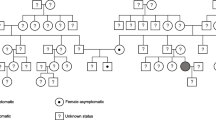Summary
An autopsy case of a 37-year-old woman with acute porphyria is reported. The patient began to complain of severe menstrual pains, and later developed serious peripheral neuropathy and various autonomic nervous symptoms.
The autopsy revealed a marked loss and degeneration of axons and myelin sheaths in the peripheral nervous system (PNS), and prominent central chromatolysis of the spinal anterior horn cells. The predominant process of the peripheral neuropathy appeared to be axonal degeneration.
Biochemical analysis showed a marked increase of delta-aminolevulinic acid (ALA), porphobilinogen, uroporphyrin, and coproporphyrin in the urine, and an increase of coproporphyrin and protoporphyrin in the stools and blood. In the analysis of the enzymatic activities of the liver and bone narrow, the activity of ALA synthetase (ALA-S) was markedly increased, and the activities of both uroporphyrinogen I synthetase (URO-S) and ferrochelatase were decreased. It was characteristic in this case that the enzymatic abnormalities found in both acute intermittent porphyria (AIP) and variegate porphyria (VP) coexisted.
Biochemical analysis of the sciatic nerve showed an increase of ALA-S activity and a decrease of both URO-S and ALA dehydrase activities. This was the first report that indicated the presence of abnormal activities of the heme biosynthetic enzymes in the peripheral nerves of porphyric patients. The possibility was discussed that these enzymatic abnormalities of the heme biosynthesis in the peripheral nerve itself might be strongly related to the pathogenesis of the porphyric neuropathy.
Similar content being viewed by others
References
Anderson PM, Desnick RJ (1980) Purification and properties of uroporphyrinogen I synthetase from human erythrocytes. Identification of stable enzyme-substrate intermediates. J Biol Chem 255:1992–1999
Anzil AP, Dožić S (1978) Peripheral nerve changes in porphyric neuropathy: Findings in a sural nerve biopsy. Acta Neuropathol (Berl) 42:121–126
Becker DM, Kramer S (1977) The neurological manifestations of porphyria: A review. Medicine 56:411–423
Becker D, Viljoen D, Kramer S (1971) The inhibition of red cell and brain ATPase by delta-aminolevulinic acid. Biochem Biophys Acta 225:26–34
Becker DM, Viljoen D, Kats J, Kramer S (1976) Reduced ferrochelatase activity: A defect common to porphyria variegata and protoporphyria. Br J Haematol 36:171–179
Bloomer JR (1981) Enzyme defects in the porphyria and their relevance to the biochemical abnormalities in these disorders. J Invest Dermatol 77:102–106
Bonkowsky HL, Bloomer JR, Ebert PS, Mahoney MJ (1975) Heme synthetase deficiency in human protoporphyria. J Clin Invest 56:1139–1148
Bornstein JC, Pickett JB, Diamond I (1979) Inhibition of the evoked release of acetylcholine by the porphyrin precursor delta-aminolevulinic acid. Neurology (NY) 5:94–96
Brennan MJW, Cantrill RC, Kramer S (1980) Effect of delta-aminolevulinic acid on GABA receptor binding in synaptic plasma membranes. Int J Biochem 12:833–835
Cavanagh JB, Mellick RS (1965) On the nature of the peripheral nerve lesions associated with acute intermittent porphyria. J Neurol Neurosurg Psychiatry 28:320–327
Denny-Brown D, Sciarra D (1945) Changes in the nervous system in acute porphyria. Brain 68:1–16
Dyck PJ (1975) Pathologic alterations of the peripheral nervous system of man. In: Dyck PJ, Thomas PK, Lanbert EH (ed) Peripheral neuropathy, vol 1. Saunders, Philadelphia, pp 296–336
Gibson JB, Goldberg A (1956) The neuropathology of acute porphyria. J Pathol Bacteriol 71:495–509
Kappas A, Sassa S, Anderson KE (1983) The porphyrias. In: Stanbury JB, Wyngaarden JB, Frederickson DS (eds) The metabolic basis of inherited disease. McGraw-Hill, New York, pp 1301–1384
Kondo M, Kajimoto M, Urata G (1983) Alteration of activities of delta-aminolevulinic acid synthase, deta-aminolevulinic acid dehydratase and delta-aminolevulinic acid dehydratase inhibitor in the bone marrow cells of lead poisoned rats. Exp Hematol 11:324–331
Magnussen CR, Levine JB, Doherty JM, Cheesman JO, Tschudy DP (1974) A red cell enzyme method for the diagnosis of acute intermittent porphyria. Blood 44:857–868
Meyer UA, Strand LJ, Doss M, Rees AC, Marver HS (1972) Intermittent acute porphyria. — Demonstration of a genetic defect in porphobilinogen metabolism. N Engl J Med 286:1277–1282
Miyagi K, Cardinal R, Bossenmaier I, Watson CJ (1971) The serum porphobilinogen and hepatic porphobilinogen deaminase in normal and porphyric individuals. J Lab Clin Med 78:683–695
Müller WE, Snyder SH (1977) Delta-aminolevulinic acid: Influences on synaptic GABA receptor binding may explain CNS symptoms of porphyria. Ann Neurol 2:340–342
Nicoll RA (1976) The interaction of porphyrin precursors with GABA receptors in the isolated frog spinal cord. Life Sci 19:521–525
Ridley A (1975) Porphyric neuropathy. In: Dyck PJ, Thomas PK, Lanbert EH (eds) Peripheral neuropathy, vol 1. Saunders, Philadelphia, pp 942–955
Sassa S, Solish G, Levere RD, Kappas A (1975) Studies in porphyria. IV. Expression of the gene defect of acute intermittent porphyria in cultured human skin fibroblasts and amniotic cells: Prenatal diagnosis of the porphyric trait. J Exp Med 142:722–731
Silbergeld EK, Hruska RE, Bradley D (1982) Neurotoxic aspects of porphyrinopathies: Lead and succinylacetone. Environ Res 29:459–471
Sima AAF, Kennedy JC, Blakeslee D, Robertson DM (1981) Experimental porphyric neuropathy: A preliminary report. Can J Neurol Sci 8:105–114
Stein JA, Tschudy DP (1970) Acute intermittent porphyria. A clinical and biochemical study of 46 patients. Medicine 49:1–16
Strand J, Felsher BF, Redeker AG, Marver HS (1970) Enzymatic abnormality in heme biosynthesis in acute intermittent porphyria. Decreased hepatic conversion of porphobilinogen to porphyrins and increased delta aminolevulinic acid synthetase activity. Proc Natl Acad Sci USA 67:1315–1320
Sweeney VP, Pathak MA, Asbury AK (1970) Acute intermittent porphyria. Increased ALA-synthetase activity during an acute attack. Brain 93:369–380
Tschudy DP, Valsamis M, Magnussen CR (1975) Acute intermittent porphyria: Clinical and selected research aspects. Ann Intern Med 83:851–864
Viljoen DT, Cayanis E, Becker DM, Kramer S, Dawson B, Bernstein R (1979) Reduced ferrochelatase activity in fibroblasts from patients with porphyria variegata. Am J Hematol 6:185–190
Whetsell WO, Sassa S, Bickers D, Kappas A (1978) Studies on porphyrin-heme biosynthesis in organotypic cultures of chick dorsal root ganglion. I. Observations of neuronal and non-neuronal elements. J Neuropathol Exp Neurol 37:497–507
Author information
Authors and Affiliations
Rights and permissions
About this article
Cite this article
Yamada, M., Kondo, M., Tanaka, M. et al. An autopsy case of acute porphyria with a decrease of both uroporphyrinogen I synthetase and ferrochelatase activities. Acta Neuropathol 64, 6–11 (1984). https://doi.org/10.1007/BF00695599
Received:
Accepted:
Issue Date:
DOI: https://doi.org/10.1007/BF00695599




